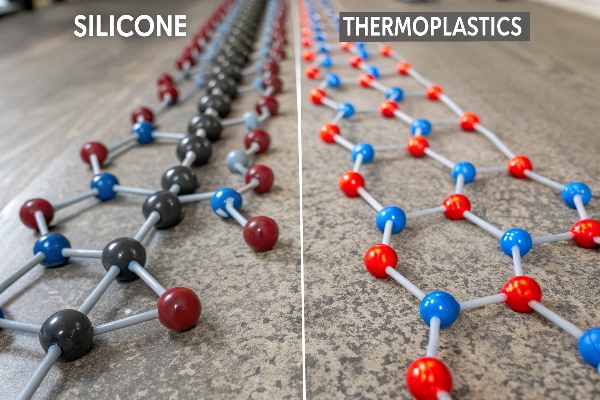You're working with high-temperature applications and worried about your silicone components failing. The consequences could be costly equipment damage, production delays, or even safety hazards.
Unlike conventional plastics, silicone rubber doesn't actually melt but undergoes thermal decomposition when exposed to extreme heat. Most silicone rubbers remain stable between -50°C and 200°C (-58°F to 392°F), though specialty formulations can withstand temperatures up to 300°C (572°F) for short periods.
I've seen the confusion firsthand when customers try to understand material limitations for their LED display installations. Let me clarify what really happens to silicone at high temperatures and why this matters for your applications.
Does Silicone Melt?
You're planning a high-temperature application but concerned your silicone components might turn into a puddle. Without knowing silicone's true thermal behavior, you risk choosing the wrong material entirely.
Silicone rubber doesn't actually melt like thermoplastics do. Instead, it undergoes thermal degradation when exposed to extreme heat. This is because silicone is a thermoset elastomer with cross-linked molecular structures that break down rather than transition to a liquid state.

Silicone's unique molecular structure explains its exceptional thermal behavior. Unlike conventional plastics with carbon-carbon backbones, silicone features a silicon-oxygen backbone (siloxane bonds) that provides remarkable thermal stability. This fundamental difference is why silicone withstands heat so effectively in various applications.
When silicone is exposed to temperatures beyond its thermal limits, it doesn't simply melt – it undergoes a more complex process. First, the material typically hardens and becomes brittle rather than softening. As temperatures continue rising, silicone begins to decompose through oxidation processes, eventually breaking down into silica (silicon dioxide), carbon dioxide, and water vapor.
Testing Silicone's Thermal Behavior
I've conducted numerous tests with different grades of silicone to observe this phenomenon:
| Temperature Range | Observed Behavior | Application Impact |
|---|---|---|
| -50°C to 150°C | Maintains flexibility and properties | Ideal operating range for most applications |
| 150°C to 200°C | Slight stiffening but functionally stable | Suitable for short-term exposure |
| 200°C to 250°C | Increased hardening, initial degradation | Risk of material failure begins |
| Above 250°C | Significant degradation, charring occurs | Rapid breakdown of material structure |
This data highlights why understanding the difference between melting and decomposition is crucial when selecting materials for high-temperature environments.
Melting Temperature Of Silicone Rubber
You're comparing materials for a critical high-temperature project, but misunderstanding silicone's thermal properties could lead to catastrophic product failure. The wrong assumption about melting points might compromise your entire design.
Silicone rubber doesn't have a true melting temperature because it decomposes rather than melts. Most commercial silicone grades begin decomposing around 200-250°C (392-482°F), though they start losing mechanical properties at lower temperatures. High-temperature specialized formulations can temporarily withstand up to 300°C (572°F).
Diving deeper into silicone's thermal characteristics reveals fascinating complexity beyond simple melting points. The temperature resistance of silicone rubber varies significantly based on its formulation and manufacturing process. Standard commercial grades typically offer continuous operating temperatures between -50°C and 200°C, while high-performance variations push these limits further.
What makes silicone's thermal behavior particularly valuable is its gradual property change rather than sudden failure. This gives engineers a safety margin that many other materials don't provide. When designing critical components, especially for LED display systems that generate significant heat during operation, this predictable behavior becomes invaluable.
Factors Affecting Silicone's Heat Resistance
The thermal performance of silicone isn't determined by a single factor but by multiple variables:
| Factor | Impact on Heat Resistance | Practical Consideration |
|---|---|---|
| Siloxane backbone structure | Fundamental to thermal stability | Higher siloxane content generally means better heat resistance |
| Filler materials | Can enhance or reduce temperature resistance | Ceramic fillers often improve thermal stability |
| Curing method | Affects cross-linking density | Platinum-cured silicones typically offer better heat resistance than peroxide-cured |
| Additives | May improve specific properties | Some flame retardants increase decomposition temperatures |
| Exposure duration | Longer exposure accelerates degradation | Short-term vs. continuous rating is critical for application design |
In our LED display manufacturing facility, we carefully select silicone compounds based on these factors, especially for components near hot LEDs or driver circuits. Through years of testing and field experience, I've found that properly specified silicone can prevent countless failures in demanding environments.
Even before reaching decomposition temperatures, silicone undergoes subtle property changes that engineers must consider. Around 150-180°C, many silicones begin to harden slightly and may experience some reduction in flexibility. This doesn't mean failure, but it could affect performance in applications requiring maintained elasticity at elevated temperatures.
Conclusion
Silicone doesn't melt but decomposes at high temperatures (200-250°C). Its exceptional thermal stability from -50°C to 200°C makes it ideal for high-temperature applications like LED displays and electronics.
About me:
My Name: Jason
My Email: 425248807


